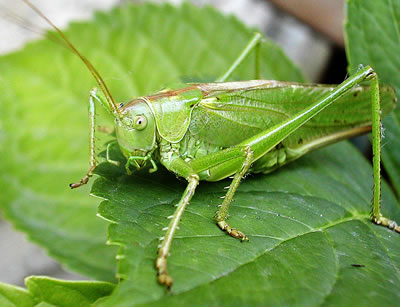Orthopterans

Facts about creatures
- Home
- Animal Classification
- Animal Habitats
- Amphibians
- Arthropods
- Bats
- Birds
- Carnivorans
- Cetaceans
- Chordates
- Crustaceans
- Dinosaurs
- Diprotodonts
- Elephants
- Fish
- Golden Mole
- Insects
- Lagomorphs
- Mammals
- Mammal Teeth
- Marsupial Mole
- Metamorphosis
- Mollusks
- Primates
- Reptiles
- Rodents
- Ruminants
- Soricomorphans
- Tenrec
- Tetrapods
- Vertebrates
Orthopterans - Crickets and Grasshoppers
Orthopterans, members of the order Orthoptera, are known for their ability to communicate by making sounds with their wings.
These insects include crickets, grasshoppers, locusts and katydids.
Orthopterans use their wings like violin bows, rubbing one wing against another, or a wing against a leg.
The wings or legs that are used for sounds production are covered with ridges.

The act of making sounds by rubbing body parts together is known as stridulation.
Among Orthopterans, sound production plays an important role in advertising territory and in courtship. It is usually the males who makes sounds.
Orthopterans undergo incomplete metamorphosis.
They have cylindrical bodies with large hind legs, which are useful for jumping, and two pairs of wings.
Lorem ipsum dolor sit amet, consectetur adipiscing elit. Ut elit tellus, luctus nec ullamcorper mattis, pulvinar dapibus leo.
Their ears are either in their abdomens (grasshoppers and locusts) or in their front legs (crickets and katydids).
Orthopterans are mostly herbivores (plant-eaters) and can sometimes cause a great deal of damage to crops.
Some species are omnivorous, and some scavenge, or prey on other animals.
Cricket Thermometer
If you count the number of chirps that a cricket makes in 15 seconds, and then add 40, you will arrive at the temperature in degrees Fahrenheit.
This formula is a simplified version of a formula that was developed by Amos Dolbear, an American inventor and physicist, in 1898.
Dolbear’s more complicated formula is
Fahrenheit temperature = 50 + (Number of chirps per minute – 40)/4
It is known as Dolbear’s Law.
A relationship between temperature and the frequency at which a cricket chirps exists because a cricket, like all insects, is poikilothermic – its body temperature varies according to the temperature of its environment. Some people refer to this as being cold-blooded.
As the weather becomes warmer, the cricket’s body temperature increases. This causes its metabolism to speed up, and it chirps at a quicker pace.
Mole Cricket
Mole crickets live in burrows. They have strong, flat front legs that are adapted for digging. Their front legs resemble the front legs of moles.